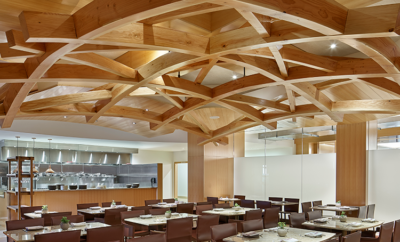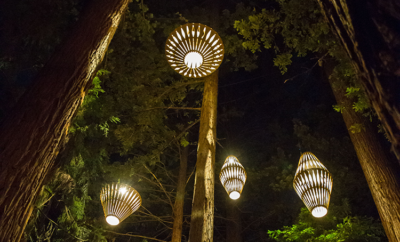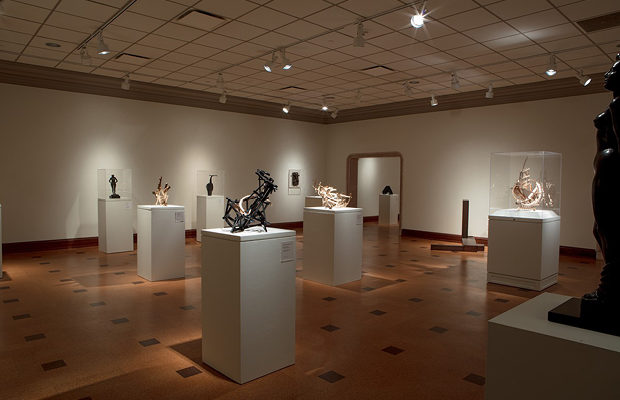 Steven J. Talley for Ball State University, September 22, 2016
Steven J. Talley for Ball State University, September 22, 2016
Exhibition
Michael Dunbar at the David Owsley Museum of Art
In 2013 the David Owsley Museum of Art at Ball State University in Indiana received Michael Dunbar’s Fallen Warrior (For Eduardo), a gift from collector Dr. Terry Travis. As is the case for many of Dunbar’s works, inspiration for the sculpture’s title is twofold: first, a reference to Henry Moore’s bronze Fallen Warrior; second, a tribute to Spanish sculptor Eduardo Chillida. Inspired by this acquisition and its historicizing title, museum director Robert La France is displaying Dunbar’s Machinist Studies, a series of sculptures smaller in scale than the monumental works for which he is best known (Fallen Warrior itself is slightly larger, at four feet tall) alongside historical selections from the museum’s own collection of sculpture, including works by Daniel Chester French, Alexander Calder, Willem de Kooning, and Tony Smith, among others. The exhibition’s title, Continuum: The Art of Michael Dunbar in the Sculptural Tradition, encapsulates the desire on the part of both curator and artist to place Dunbar’s work in the context of the masters who came before him.
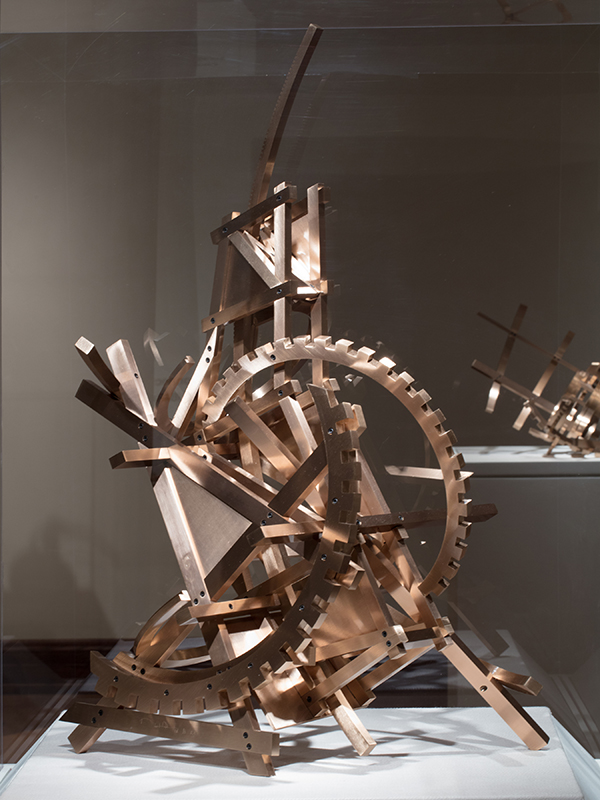
Michael Dunbar (1947–), Ride Sally Ride, fabricated and polished bronze, 2015. | Steven J. Talley for Ball State University, September 22, 2016
Though at first glance Dunbar’s work seems exceedingly abstract, the exhibition makes clear that he is in constant dialogue with the figurative tradition. And, despite their mechanical appearance, Dunbar’s sculptures possess a certain sensuality. The gear-like yet organic curves of the Machinist Study Chi-Cyclotron, for example, evoke a female nude, especially when seen in tandem with Degas’ Pregnant Woman. As art critic Ann Landi writes in the exhibition catalogue, “the complicated joinery and parts [of the Machinist Studies] recall the precarious acts achieved by Bernini in The Rape of Persephone and Daphne and Apollo.” Dunbar is in the business of assembling figural compositions from pseudo-technological components, in much the same way as mid-century automobiles mimicked the curves of the human form in solid steel.
If there is one thing Dunbar continually references besides the body, it is the technological forms of the past. Though one may think these sculptures are amalgamations of found objects from antique machines, they are, in fact, fabricated from scratch by the artist and his workshop. The Machinist Studies are informed by everything from nineteenth-century clipper ships to the first solid-body electric guitar, as seen in Black Moon Raker and Telecaster, respectively. These references do not simply represent an appeal to nostalgia, however, but, as La France says, they evoke “more of a deep faith in technology and scientific instrumentation.” Certainly, there is an aspect of “looking backward” in Dunbar’s work, but this is not limited to the present gazing into the past. The sculptor’s latest series, Relics from the Future, imagines a viewer in the distant future examining machinery made a hundred years earlier.
While the catalogue for Continuum explores the multivalent nature of these sculptures in great depth, the exhibition itself places more emphasis on the individual’s personal interaction with and interpretation of the work. These sculptures are presented, after all, in a university museum, and La France has taken great care to consider the exhibition’s main audience: the students of Ball State. Viewers are given the tools of formal analysis, with the “elements of sculpture” displayed on one wall providing a vocabulary, such as “texture,” “mass,” and “rhythm,” but they are not explicitly guided to any one narrative. Museumgoers can even assemble their own sculptures in the exhibition’s “Maker’s Space,” using cardboard, styrofoam cups, and paper plates to create surprisingly Dunbar-esque forms. And, while the Machinist Studies are presented alongside sculptures from the nineteenth and twentieth centuries, the comparisons are not one-to-one, but a series of collective impressions, allowing connections to be made freely between past and present. The result has been what La France calls “an overwhelming response” from Ball State’s students.
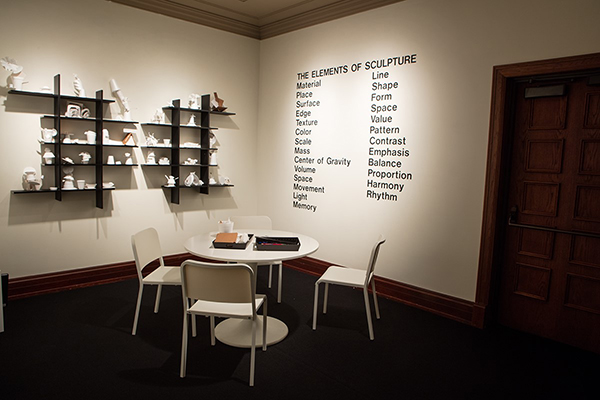
Continuum‘s “Maker’s Space,” featuring the sculptures of Ball State University Students | Steven J. Talley for Ball State University, September 22, 2016
Yet another Machinist Study featured in the exhibition bears the title Buck’s Embarkation. Dunbar explains that this sculpture is named after Buckminster Fuller, inventor of (among other things) synergetic theory, which Fuller defined as the “behavior of whole systems unpredicted by the behavior of their parts taken separately.” Continuum, in its novel approach to displaying the Machinist Studies, not only does justice to Dunbar’s legacy within the history of modern sculpture, it also creates a truly synergetic relationship between viewer and artwork, material and form, and space and time—something that surely does not go unappreciated by Dunbar himself.
CONTINUUM: The Art of Michael Dunbar in the Sculptural Tradition is on show at the David Owsley Museum of Art at Ball State University through December 19, after which it travels to the University of Notre Dame where it is on show from January 29 through March 5, 2017.


